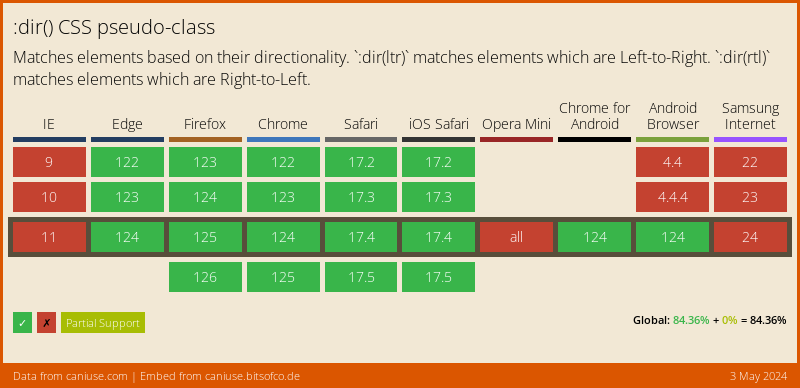Package Exports
- postcss-dir-pseudo-class
- postcss-dir-pseudo-class/dist/index.cjs
- postcss-dir-pseudo-class/dist/index.mjs
This package does not declare an exports field, so the exports above have been automatically detected and optimized by JSPM instead. If any package subpath is missing, it is recommended to post an issue to the original package (postcss-dir-pseudo-class) to support the "exports" field. If that is not possible, create a JSPM override to customize the exports field for this package.
Readme
PostCSS Dir Pseudo Class 
PostCSS Dir Pseudo Class lets you style by directionality using the :dir()
pseudo-class in CSS, following the Selectors specification.
article h3:dir(rtl) {
margin-right: 10px;
}
article h3:dir(ltr) {
margin-left: 10px;
}
/* becomes */
[dir="rtl"] article h3 {
margin-right: 10px;
}
[dir="ltr"] article h3 {
margin-left: 10px;
}Maintaining Specificity
Using PostCSS Dir Pseudo Class will not impact selector weight, but it will
require having at least one [dir] attribute in your HTML. If you don’t have
any [dir] attributes, consider using the following JavaScript:
// force at least one dir attribute (this can run at any time)
document.documentElement.dir=document.documentElement.dir||'ltr';If you absolutely cannot add a [dir] attribute in your HTML or even force one
via JavaScript, you can still work around this by presuming a direction in your
CSS using the dir option, but understand that this will
sometimes increase selector weight by one element (html).
Usage
Add PostCSS Dir Pseudo Class to your project:
npm install postcss-dir-pseudo-class --save-devUse PostCSS Dir Pseudo Class to process your CSS:
const postcssDirPseudoClass = require('postcss-dir-pseudo-class');
postcssDirPseudoClass.process(YOUR_CSS /*, processOptions, pluginOptions */);Or use it as a PostCSS plugin:
const postcss = require('postcss');
const postcssDirPseudoClass = require('postcss-dir-pseudo-class');
postcss([
postcssDirPseudoClass(/* pluginOptions */)
]).process(YOUR_CSS /*, processOptions */);PostCSS Dir Pseudo Class runs in all Node environments, with special instructions for:
| Node | PostCSS CLI | Webpack | Create React App | Gulp | Grunt |
|---|
Options
dir
The dir option allows you presume a direction in your CSS. By default, this
is not specified and you are required to include a direction [dir] attribute
somewhere in your HTML, preferably on the html element.
Here’s an example of using the dir option to presume a left-to-right
direction:
postcssDirPseudoClass({ dir: 'ltr' });.example:dir(ltr) {
margin-left: 10px;
}
.example:dir(rtl) {
margin-right: 10px;
}
/* becomes */
html:not([dir="rtl"]) .example {
margin-left: 10px;
}
[dir="rtl"] .example {
margin-right: 10px;
}preserve
The preserve option determines whether the original :dir() rule should
remain in the CSS. By default, the original rule is not preserved.
postcssDirPseudoClass({ preserve: true });article h3:dir(rtl) {
margin-right: 10px;
}
article h3:dir(ltr) {
margin-left: 10px;
}
/* becomes */
[dir="rtl"] article h3 {
margin-right: 10px;
}
article h3:dir(rtl) {
margin-right: 10px;
}
[dir="ltr"] article h3 {
margin-left: 10px;
}
article h3:dir(ltr) {
margin-left: 10px;
}

